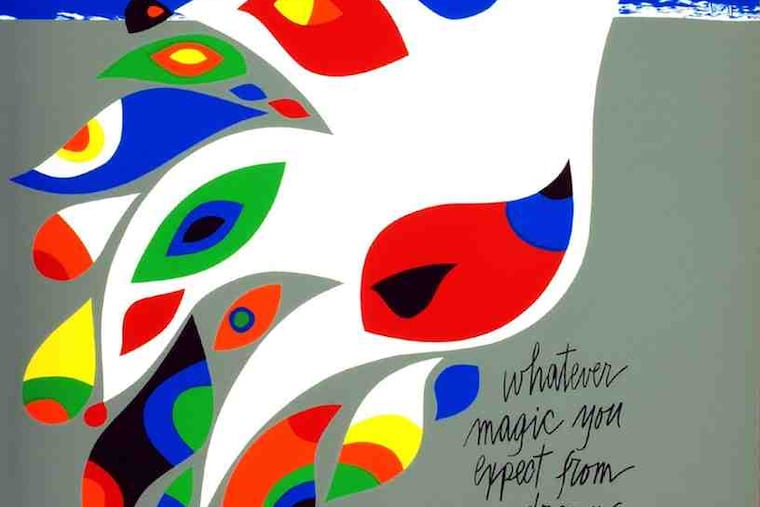His murals, prints and other art shown at Woodmere.
Sam Maitin's approach: 'If it's not fun, it's not art'

Sam Maitin's art - murals, prints, sculptures and more than 500 poster designs for clients and causes - was a celebration of life. He insisted, "If it's not fun, it's not art." As one of Philadelphia's most beloved artists, his work is richly deserving of the celebratory exhibition "Sam Maitin: Prints & Places" now at the Woodmere Museum in Chestnut Hill.
Life was very precious to Maitin (1928-2004), and his highest priority as an artist was to improve the lives of those around him by reducing the distance between art and life. Flatly refusing to be an illustrator of agony, he once told an interviewer, "I see ugly art as sad, like withdrawal. I see it as an inability to cope - as if the artist really is a raw nerve."
Opulence in art bothered him nearly as much. Collage turned out to be his favorite medium because it was intuitive, frantic and very quick - like himself. So keenly did he value freshness in his image-making that he preferred to throw away an artwork rather than belabor it.
A highlight of "Sam Maitin: Prints and Places" is the first showing of 30 prints given to Woodmere by the artist's widow, Lilyan Maitin, and the Maitin family to honor Michael W. Schantz, who stepped down after 25 years as museum director a year ago.
Surrounding the color, shapes and texts in this vital nucleus of prints are additional Maitin works from the permanent collection, others that are studies for mural or sculptural projects in public places, either institutional or private, on loan from Lilyan Maitin and family. Also displayed are several very new gifts, made when their owners heard about this show.
Fondly remembered is Woodmere's mammoth 260-piece Maitin exhibition of 1994 - a vivid wake-up call that this venerable institution would seem an ideal future home for a well-rounded permanent Maitin collection. For the moment, however, the current show affords an excellent opportunity to begin the task of charting development of Maitin's 1958-1980s prints, his work in collage, and his public sculpture. Already, close and deepening study has begun. But first and foremost, this art is fun.
Building on the box
"Inside and Outside the Clamshell Box: Diary of a Print Portfolio" at Delaware County Community College features a special-occasion portfolio of prints by 28 area artists. That 2010 portfolio, "Mark/Remarque," is the centerpiece of a larger show featuring supplementary work gathered from each of the participating artists.
What's most effectively set forth here is the consistency some artists are able to achieve as they further amplify their portfolio print: Even if they change media, they tend to be definite yet subtle about it. Artists who make the strongest case for such consistency in their work on view include Joan W. Curran, Dan Dallmann, Christopher Hartshorne, Daniel Heyman, Tony Rosati, Bill Scott, Evan Summer, and Rochelle Toner.
The idea behind the exhibition may seem too much of a reach to be practical. But actually this show quite usefully demonstrates, both for students and for the public, what the creation of a printmaking portfolio entails. And it takes a closer look at the active and talented participants in our region's most notable recent print portfolio project - quite a commendable effort on all sides.
Bird song
Naeem Rana, a Pakistani artist in his 30s with college degrees from his native land and from Australia, shows large colorful digital prints on archival paper in his solo "Samunder Paar" at Twelve Gates Gallery.
From a family of Urdu calligraphers, and trained in that art by his father following centuries-old tradition, Rana is now a Melbourne resident, having lived for a time in Philadelphia. His solo show mainly features his new series of digital prints using poetry and calligraphy to capture nostalgia and a sense of displacement, in a children's poem, "Bulbul ka bacha." It tells of a nightingale and its fledgling, using layered imagery, such as traditional Kashi floral patterns and 15th-century indigenous illuminated manuscripts to suggest overlapping cultural settlements Rana remembered as a child in Lahore. This is a show secure in technique, in artistic conception and in its social meaning.